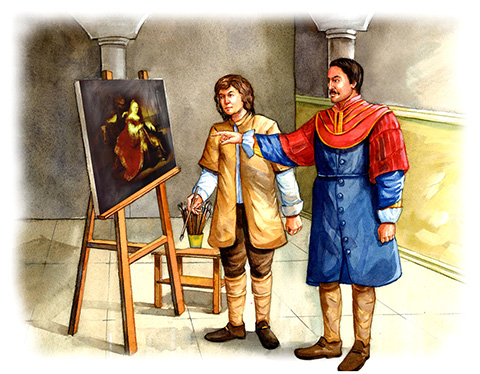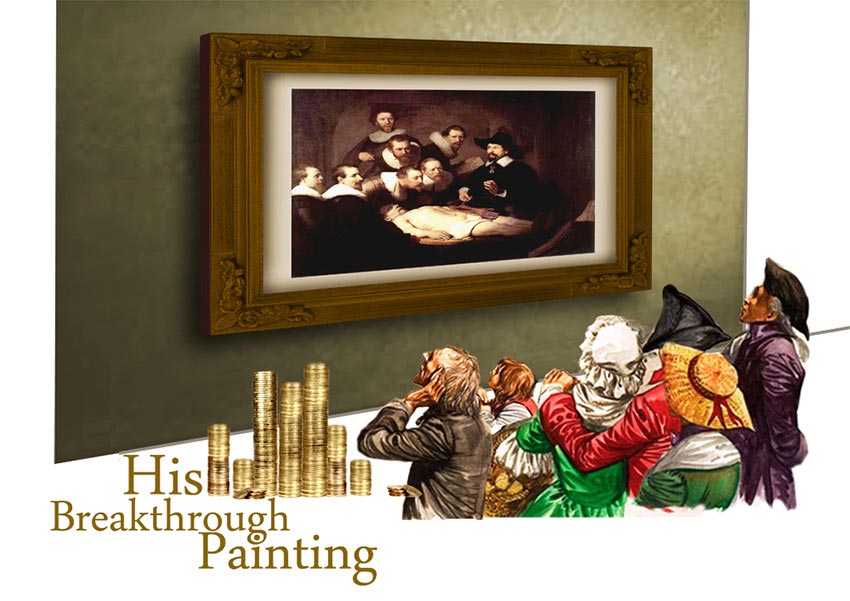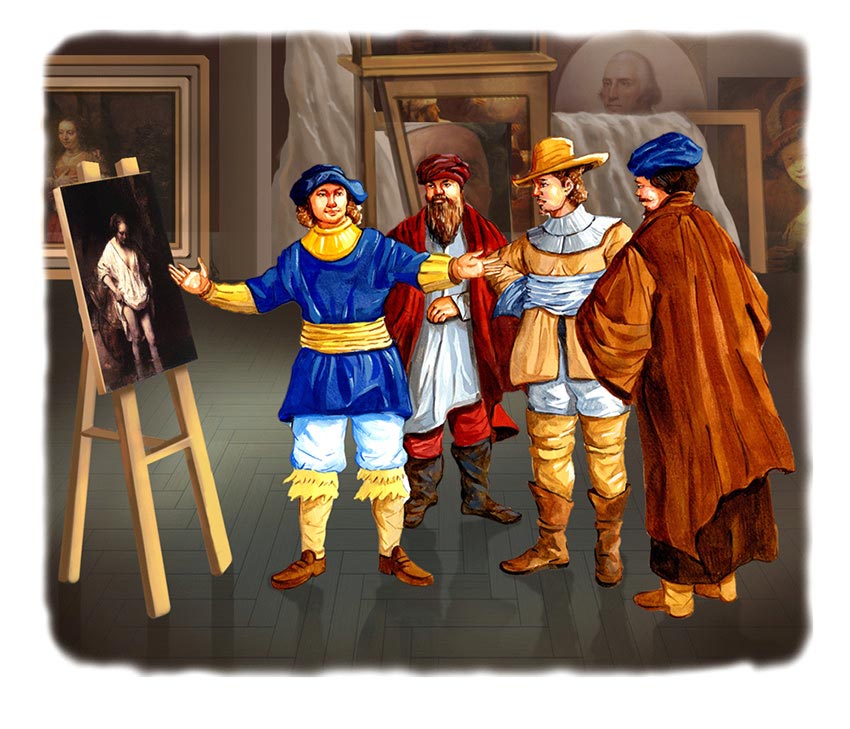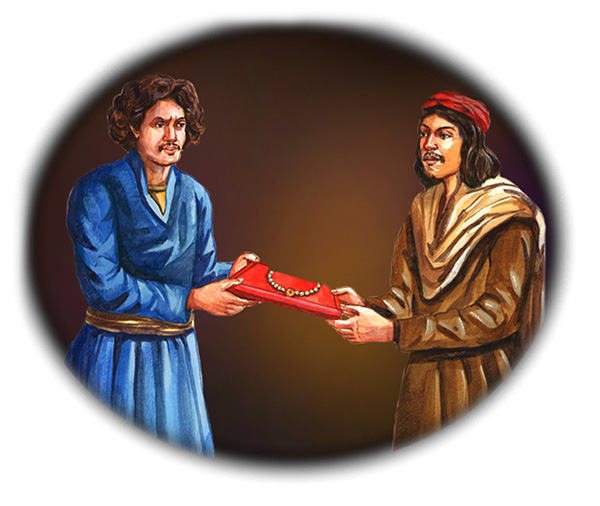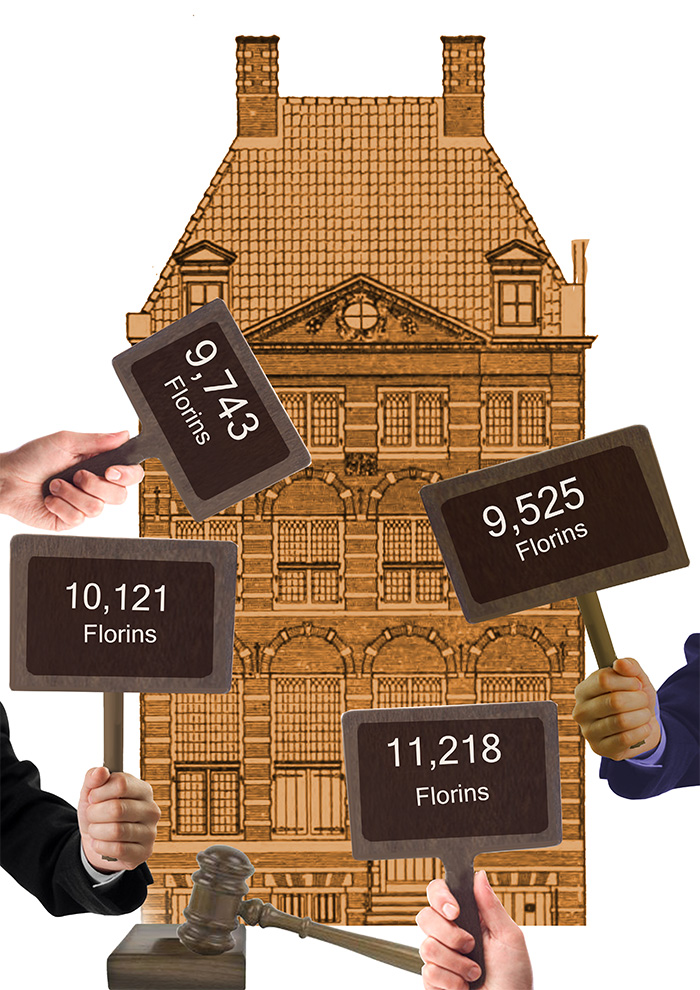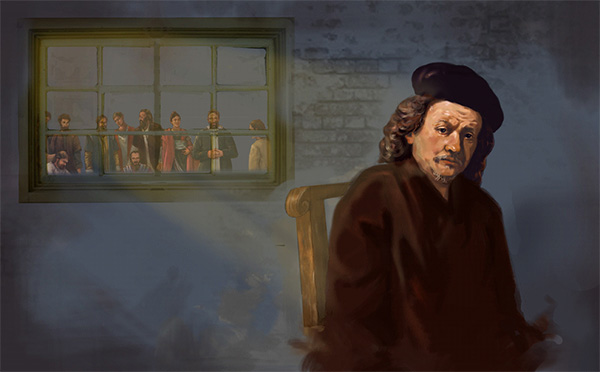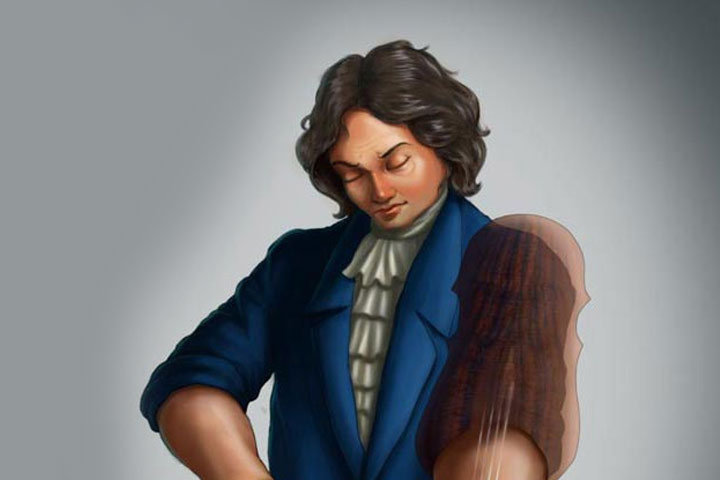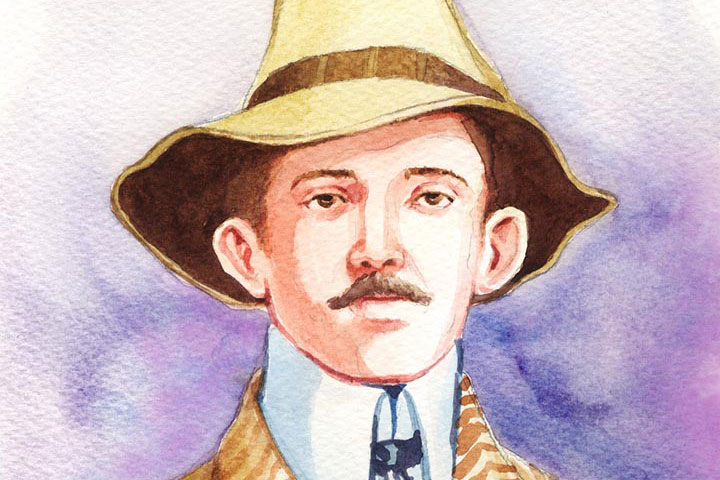
The enigmatic eyes of Rembrandt
Spendthrift or a miser,
Introvert or generous,
Stubborn or a maniac,
Zealous or reckless
Indeed, there is no scarcity of names to describe the painter Rembrandt Van Rijn. But one thing which says it all about him is, ‘the most immaculate painter’ ever born. The man, whose eyes could unveil the hidden mysteries behind every face, wore innumerable masks all his life. ‘Beauty lies in the eyes of the beholder’ was true in the case of Rembrandt; he possessed the art to transform the ugliest of face into the most beautiful painting. He once said “Of course you will say that I ought to be practical and ought to try and paint the way they want me to paint. Well, I will tell you a secret. I have tried and I have tried very hard, but I can’t do it. I just can’t do it! And that is why I am just a little crazy.” All thanks to his craziness; had he not been crazy we would never have experienced the ‘reality’ behind the numerous human emotions. Isn’t it astounding that he leaves us pondering even today?

Born in the Cradle of Scenic ‘Leiden’
The beautiful Leiden in Netherlands which is known for its cultural heritage today, back in the seventeenth century was a picturesque, rich and prosperous city surrounded with canals. In the midst of these beautiful canals and the River Rhine lay a commodious, House No. 3, in the Weddesteeg, where a miller, Herman Gerritszoon Van Rijn lived with his beautiful wife Comelia (Neeltjan), the daughter of a baker. The contented couple was already blessed with seven children. Soon, on 15th July, 1606 they were blessed with their last child whom they named Rembrandt Van Rijn.
Whereas on one hand, the infant Rembrandt was smiling in his cradle, on the other hand, the seed of dissention was gradually sowing in his land. The religious and civil agitations were soon becoming visible in the air of Leiden. But all that Rembrandt’s tender eyes could see was the magnificent beauty of the city around him; the blue sky filled with clouds, the sun setting across the canals, the beautiful green trees and the scenic splendour which was the essence of the city. He spent his early years playing near the sinuous Rhine river and wondering how beautiful and enchanting nature was.

Being born in a miller’s house, the profession that Rembrandt could have possibly chosen then, would have been of a baker or a miller, but his parents knew the significance of education. They sent him to The Latin School at the age of seven, with a dream to transform him into a statesman who would serve the city and republic with his knowledge. Rembrandt attended The Latin School since then, which laid immense emphasis on Catholicism. The curriculum included the reading of catholic books of Cicero, Terence, Virgil, Ovid, Horace, Caesar, Sallust, Livy and Aesop. Apart from catholic teachings, there was one more thing which Rembrandt learnt from his school; the Latin language. All his classmates and friends in school conversed in Latin and soon Rembrandt also became proficient in the language.

The Follower of His Heart
During those days, the purpose of The Latin School was to prepare young men for the University of Leiden, which also seemed to be the next step on Rembrandt’s academic ladder. He began his education in The Leiden University but his heart did not permit him to continue with it. There was no doubt that Rembrandt was different from others; he did not want education, money or anything else. His only wish was to follow his heart, which repeatedly asked him to paint. He was a master of his own life; lost in the midst of his own small but beautiful world.
Although Rembrandt’s parents always desired that he would grow up and become a statesman, Rembrandt’s quest for painting forced them to encourage their child’s love for art. They soon sent him to Jacob Van Swavenburgh, an obscure and ‘not too talented’ Leiden painter, to learn the art. Van Swavenburgh taught Rembrandt the fundamentals of painting, but he could not make a deep impression on his pupil. Most of Van’s paintings consisted of ‘Architecture’ and ‘Hell’ whereas Rembrandt did not lay much emphasis on these subjects. After three years of basic understanding of his art, Rembrandt had absorbed all that Van could teach him. The remarkable progress in Rembrandt’s art was astounding for one and all and the presence of a master was already reflecting through him.
During the time Rembrandt spent in Swavenburgh’s studio, he was accompanied by a fellow citizen Jan Lievensz who was a year younger to him. Jan’s father, a farmer probably, had some business connections with Rembrandt’s father and both belonged to the same rank of society. It was certain for Rembrandt and Lievensz to be friends, as their goals were also similar. Soon, the friendship between them flourished while they learnt the art together and the intimacy between them progressed to an extent of being inseparable. Jan had returned from Amsterdam after completing his studies in the studio of Peter Lastman, one of the most famous painters of historical scenes in the United Provinces at that time. It is possible that Jan shared his experience with Rembrandt which ultimately pushed him to go to Amsterdam where he could gather knowledge from Lastman. His friend’s advice and his quest to paint, led Rembrandt to Amsterdam in 1624 to study under Pieter Lastman. Lastman was much inspired by the Italian painters Caravaggio and Adam Elsheimer. Their outstanding qualities of bold naturalism, dramatic power, mysterious depths, exquisite day light, nocturnal effects and specially the interplay of light and shadow were inculcated in Lastman which he ultimately passed on to Rembrandt. Although Rembrandt spent a very short time in Peter’s studio, the knowledge that he acquired there was immense.
He seized the art of using the Chiaroscuro device (the distribution of light and shade in a picture) and within a short span of time began to use it with a skill which no other artist had ever possessed.
From Lastman, Rembrandt learnt his early style of using bright glossy colours and lively theatrical gestures in paintings. Rembrandt was also inspired by the art of history paintings from him. During those days, history paintings did not hold much importance and the ordinary art buyers were not very keen to buy them. They rather preferred subjects like scenes of everyday life, landscapes and still life. But the nobility of the art rested in painting the famous past, specifically the Biblical past. Though the trend demanded a painter to inculcate in secondary art theory, Rembrandt was engrossed in painting history and dedicated himself to it with a fervour which lasted a lifetime. This led to his preoccupation with always painting history; mainly scriptures.
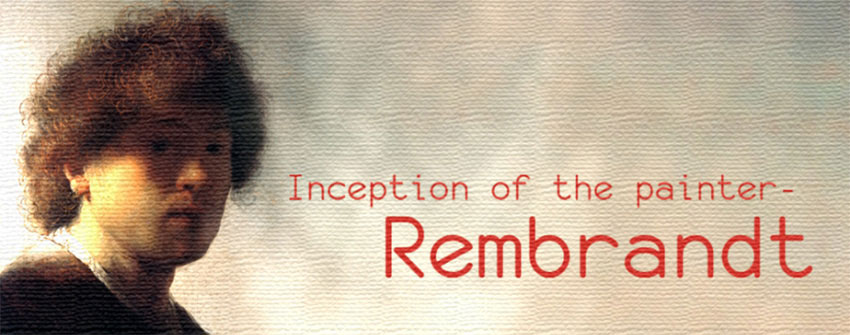
Inception of the Painter- Rembrandt
Probably, in 1625, around the age of 18 or 19, Rembrandt left Lastman with a desire to study and practice painting alone in his own way. He settled in his father’s house and set himself up in Leiden as an independent artist. He began painting and got so engrossed that he even forgot the count of time;

It was an endless desire within him which pressed him to keep painting. Not only was he emerging into a great painter, but he was also mastering the art of etching (an art process where a painter uses glass, copper or a needle to carve on a stone or wall). During those days, Rembrandt was also rapidly developing himself into a graphic artist. Until the year 1628, Rembrandt had created a sensation throughout Leiden as an artist. Though people considered him premature, his art reflected his magnitude. At the young age of 21, Rembrandt had already transformed into a pedagogue; his first pupil was Gerard Dou who was only 14.
In the year 1930, Rembrandt’s career was flourishing, but unfortunately his personal life was hit by his father’s death. Indeed, the blow must have been a heavy one as Herman was an encouraging father and a loving companion to his children. Though sadness surrounded Rembrandt for a while due to his father’s death, it could not stay for long in his life. Success was about to touch his feet very soon.
During those days, the prince of Orange (a title of nobility associated with the principality of Orange, in what is now southern France) decided to build a palace styled after the Greek and Roman architecture. He chose Constantine Huygens as his assistant to decorate the palace with art. All this while, Rembrandt and his friend Jan, had gained immense reputation in the field of superior art spreading to ‘The Hague’ (the capital city of the province of south Holland in Netherland.) Soon, this news reached the ears of Huygens and he found out about Rembrandt and Jan. He was so astounded with Rembrandt’s work that he once wrote in his diary, “not even Appelles (one of the very first Greek painters) would have imagined what a young fellow, a Dutchman, the son of a miller, a beardless man, could muster and express.” The prince could not believe what his eyes were seeing and soon he began paying the two artists commissions and a good amount of six hundred guilders for each painting. But Huygens soon found out that Rembrandt was difficult to work with due to his complicated personality. Though a great painter, he was incapable of handling money, unable to express himself and his opinionated views on art seemed to be an obstacle in his path to success.

And the Journey Begins…
By 1631, Rembrandt’s reputation ripened to such an extent that his name and fame overflowed the boundaries of Leiden and travelled far away to the streets of Amsterdam. As a result, umpteen number of commissions started coming to him. To finish the same, he headed to Amsterdam, stayed there for a short period of time and lodged with Van Uylenburgh. Van had a successful art gallery with an ‘academy’ attached, where young painters were trained. Rembrandt began teaching in the academy while he completed his commissions.
Though Rembrandt returned to Leiden after a short span of time, his destiny demanded him to go back to Amsterdam. The first reason was that Leiden during those days was a ‘university’ town which did not consider art as an important element; in fact the little coterie of artists was also on the verge of decline. In contrast to Leiden, Amsterdam was a city of the ‘rich’ and ‘wealthy’ who had a penchant towards lavish portraits of themselves and paintings of the incidents. Second reason was that King Charles I had sent an invitation to Rembrandt to visit England and paint ‘The Anatomy Lesson of Dr Nicolaes Tulp’, a large group portrait. Indeed, to take up a task so large and important, it was necessary for Rembrandt to lodge in Amsterdam. But the obstacle that stood in his way was his affection and attachment towards his mother. For an emotional man like Rembrandt, it was difficult to stay away from his beloved mother. However, in the end, ‘survival’ won over ‘emotions’ and in order to carve an identity for himself and also earn his livelihood, Rembrandt left for Amsterdam, probably towards the end of 1631.Amsterdam was almost the hub of the trade universe then and Rembrandt decided to take full advantage of the scenario in the richest city.
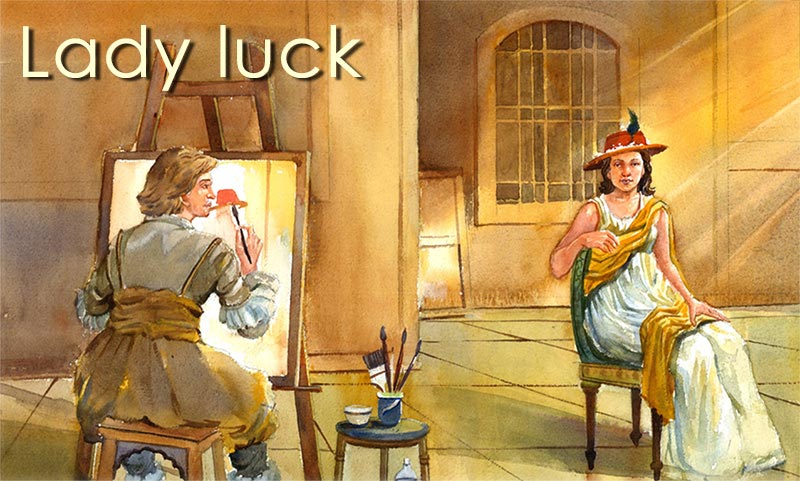
Lady luck
When Rembrandt went back to Amsterdam he dwelled in his previous lodge with Van Uylenburch for a while. During this time, he loaned his friend Van a sum of 1000 florins. Though this act of Rembrandt seems to be strange when he himself was searching for a place to dwell, the truth was something else. There was a strong motive behind this act of kindness which Rembrandt showed towards Uylenburch. The reason was none other than the feeling of love. Rembrandt was lost in the dreams of Uylenburch’s cousin, Saskia Van Uylenburch. It seemed, he wanted to be in Van’s good books so that he could marry the enchanting Saskia. The exact time when love entered the painter’s life is still a mystery, but it was maybe during the first time he flew to Amsterdam. Every artist’s heart is filled with love; similar was the case with Rembrandt. He could not resist falling in love with the alluring cousin of Van. Maybe, Saskia stole his heart the moment he met her. When Rembrandt met Saskia, she belonged to a wealthy and wholesome family of five sisters and three brothers. She had all the riches to make her feel like a princess, but still there was an empty space within her because of the demise of her parents.
Rembrandt’s feelings towards Saskia would often pull him to The Sylvius House, as Jan Cornelius Sylvius was then the guardian of Saskia. The romance flourished between the two young souls and they decided to be together until eternity. For a painter like Rembrandt, Saskia was an added flavour to his art. With a pleasant smile, she was enchanting in her own way. She was not only the love of his life, but also the model of many of his paintings.
Saskia became the reason why Rembrandt’s desire to paint kept growing day by day.
In his personal life, Rembrandt had already proved himself by winning Saskia’s heart and now it was time for him to succeed in his professional life as well. It was the year 1632 when he finally completed his painting ‘The Anatomy Lesson of Nicolaes Tulp’ which was also his first large group portrait. This was also the time when Rembrandt’s career began to flourish immensely and he gathered immediate appraisal and extreme applause for the painting.
He had turned out to be the most fashionable painter of portraits. Rembrandt was so engrossed in his art, that he painted nearly forty portraits between the years 1632 to 1634, gradually rising to a total of 102 paintings by the year 1636. Commissions kept flowing faster than he could execute them. It seemed as if the entire wealth of Amsterdam had begun to drop into Rembrandt’s cottage. People waited for months to get painted by him. The way he could bring out emotions on a piece of paper was surprising and astonishing for one and all. Every second person in Amsterdam wanted Rembrandt to immortalize him in his paintings. Along with this, many pupils came clamouring to his doors; amongst them were Govert Flinck (a Dutch painter), Ferdinand Bol (a Dutch artist, etcher and draftsman), Philips Koninck (a Dutch landscape painter), Gerbrandt Van Den Eeckhout (an etcher, an amateur poet, a collector and an adviser on art), Jan Victors (a Dutch painter that focused mainly on painting subject from the Bible) and Leendeert Cornelisz (a Dutch architect). They were so eager to work with Rembrandt that the fees of 100 florins a year did not seem expensive to them at all. Rembrandt was at the peak of his glory and fame.
It may be said that fortune was so much in Rembrandt’s favour during this period of his life that even if he would have wished for the most impossible thing ever, he would have got it. But Rembrandt did not yearn for fame; all that he craved at this moment was his darling Saskia’s hand in marriage. Fortunate as he was then, Sylvius immediately approved of his marriage with Saskia, the only obstacle being Saskia’s young age. Though Saskia belonged to a rich family and Rembrandt did not have the wealth that the husband of Saskia was expected to have; yet, Sylvius approved the marriage. The sole reason behind his decision was that Rembrandt had already carved himself above all pedigrees. Finally, the wedding was decided which filled the artists heart with delight.
Everything was in place and nothing could stop Rembrandt from marrying Saskia and filling his life with happiness. Unfortunately, things took a different turn all of a sudden when Saskia was called to Franeker( a town in Friesland) to take care of her ailing sister Antje. However, Antje soon passed away and Saskia had to spend the entire winters with her sister Hiskia. Rembrandt who was wishing to marry Saskia as soon as possible was very unhappy and gloomy with this impediment in his marriage plans. He spent his entire winter toiling discontentedly in his studio at Amsterdam.
In the spring of 1634, the mourning period gradually neared its end and finally on 14th June, Rembrandt presented the necessary documents of his mother’s consent (Sylvius had asked Rembrandt to get his mother’s consent for the marriage) and requested that the formal preliminaries should be cut as short as possible. Whether he really wrote to his mother or not, we do not know, but it seemed sure that he was in a hurry to make Saskia his wife. He did not want to waste a single moment; all he wanted, was to marry Saskia as soon as possible. Finally, his long awaited dream turned into a reality and he married Saskia, the love of his life, on 22nd June, 1634.
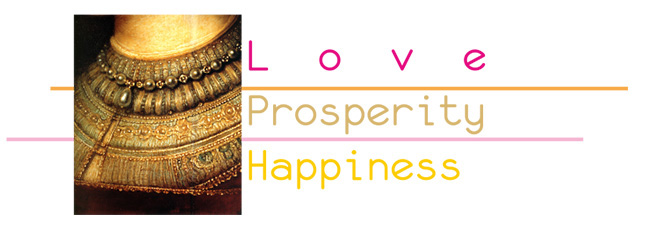
Love, Prosperity, Happiness
Rembrandt’s happiness knew no bounds when he married Saskia and their relationship prevailed to be a successful one even after marriage. Saskia was an endearing woman, a statuesque model and an obedient wife. But was that enough for a man like Rembrandt? A man who is adamant, strong-willed, recklessly generous, prodigal and carefree definitely needs a wife who would be amorous yet firm to control him. With Rembrandt’s lavish expenses and his habit to spend without thinking about the future, he needed someone who could manage his expenses, regulate his household and introduce some order into his lackadaisical ways. But Saskia being saccharine and obedient was not the woman who could take charge of Rembrandt’s extravagant spending habits. Her love for Rembrandt couldn’t restrict him from spending lavishly and Rembrandt’s love for Saskia failed to stop him from buying costly jewels for the lady.
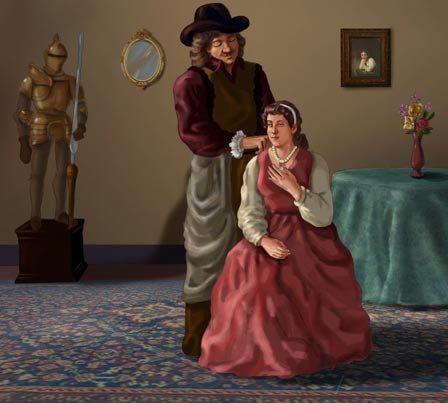
Rembrandt was an impulsive buyer of works of art, pictures, engravings, castes and statues, armour and curious objects. Though he was habituated to collect works of art previously as well, by now, it had almost turned into an obsession. During auctions, anything he desired, he would run it up in one bid to a wholly impossible price, such that, he could own it. Although, according to him, he was paying honour to his art, the truth was that he was a spendthrift.
In the midst of supreme happiness, there came one more good news knocking at Rembrandt’s door. In the summer of 1635, Saskia was noted to be pregnant. In early winter, on 15th Dec, 1635 she gave birth to their first child, a son named Rombertus. Rembrandt was delighted with joy and he couldn’t resist painting sketches of his son and Saskia, but alas, the happiness which surrounded the family was short lived as they were hit by Rombertus’ death very soon.
By 1636, when Rembrandt was at the height of his prosperity and fame he improved his residence to an expensive house on Nieuwe Doelenstraat( street in Amsterdam). His imitators were emerging throughout Holland, but there could be no other Rembrandt. Though Rembrandt was relishing the present, he was unaware of the melancholy that was about to hit him.

Storm clouds begin to brew…
Following the month of January 1638, a number of lawsuits commenced between Rembrandt and several of his family members. One of them contains a document dated 16th July, 1638 which unveils the temperament of both the parties involved in previous lawsuits. Rembrandt’s brother-in-law Ulricus Uylenburgh declares, “he and his wife were richly and ex superabundantid provided with goods, for which they could never be sufficiently thankful to the Almighty; notwithstanding which the defendants had permitted themselves to insinnate that his wife, Saskia, had squandered her patrimony in parade and ostentation.”
The hot headed brothers-in-law of Saskia possessed ruffled feelings towards her and Rembrandt and blew out the reports saying, she had “dissipated her paternal inheritance in dress and ostentation”. Though Rembrandt was enraged with the accusations and considered it as an insult; the fact was that all the allegations were probably true. However, the thrust at Saskia angered Rembrandt more than the one which would have hammered him alone. He demanded the court to condemn the defendants to pay him and his wife respectively, an indemnity of sixty four goudguldens (currency of Netherlands). The defendants answered that neither Rembrandt nor Saskia have been named in the arraigned document and the words which Rembrandt’s advocate Uylenburgh has interpreted as an insult, were used without any intention in that pretext. Nevertheless, if they still find themselves injured, they were willing to pay them eight goudguldens which was enough to satisfy a painter and his wife. The court decided that there was no offense in the case and declared the plaintiff, non-suited.
In the midst of all the mess, Rembrandt discovered happiness with the birth of his second child, a baby girl named Cornelia, on 1st July, 1638.Though delighted, Rembrandt was stuck in a state of financial embarrassment. The strongest evidence which proves his condition is the letter which he wrote to Constantine Huygens during that time:
“Worthy Sir: I have full faith in you, particularly as regards the [matter of my] remuneration for the last two pieces. If things had gone according to your wishes and to propriety, no objection would have been raised to the asking price. As for the pieces [which were] delivered previously, no more than 600 k. guilders were paid for each of them, and if His Highness cannot be persuaded in the face of valid arguments to pay a higher price, even if they are obviously worth it, I shall be content with 600 k. guilders each, with the provision that reimbursement shall be authorized for my [cash] outlay of 44 guilders for the two ebony frames and the crate. Therefore, I ask you, Sir, kindly [to intercede] that I might soon as possible receive payments here in Amsterdam, and I trust with [your] kind help on my behalf I shall soon be able to enjoy my pennies, and I shall remain grateful for all you acts of friendship.. ..”
The major reason behind this urgent need of money seemed to be the instalment of Rembrandt’s new residence which was due on him. Delighted with the birth of Cornelia, he had decided to settle himself in a ‘House No. 68’ at Joden Breestraat, for 13000 florins. Though he had to pay the instalments in next five to six years, he wanted immediate possession of the house and so he cleared almost half the amount and took the possession by May 1639.

The Shadow of Darkness
It seemed that everything was the way Rembrandt coveted it to be; a perfect house, a beautiful wife, an adorable daughter and his career at peak. But amidst all happiness, the heavy blows which were about to struck him were still veiled. Just three weeks after her birth, baby Cornelia passed away on July 29. Somehow, Rembrandt managed to recover from this tragedy only to be plunged into darkness once again when his beloved mother passed away in the year 1640. It is said, that after the demise of his mother, Rembrandt used to be lost in her memories for days. In the same year, Rembrandt suffered another major loss when his third child, a daughter (again named Cornelia), passed away in just one month after her birth. Indeed, it was a mournful situation for Rembrandt as his affection for his mother and his daughters was immense.
But in the midst of the sorrow he was once again filled with delight when good news knocked at his door; Saskia was once again pregnant. It seemed happiness was re-entering the painter’s house, but unfortunately, the storm was yet to come. On 16th September, 1641, Saskia gave birth to a son, Titus. Unfortunately, she never enjoyed a good health after that. Though Saskia had all the jewels in the world, all the love that Rembrandt could shower and a loving son, but sadly, she did not have enough strength to enjoy the happiness she was blessed with. By the following spring, Saskia’s health began to deteriorate and thus, on 5th June, 1642, she made her will. It stated, that ‘practically everything was left to Rembrandt after her death, and she was sure Rembrandt would properly educate Titus and take care of his future. Apparently, her share of the estate was left for Titus along with any child whom she would bear in the near future, although she was sure she wouldn’t. Rembrandt was the owner of all the property, principal and interest unless he married again. In that case, half of the property was to be put in trust for her child and the rest of the interest could be enjoyed by her husband.’ It was clear that she did not have much time; she knew she was soon going away forever from Rembrandt and Titus.
Indeed, she died on the following fortnight. With Saskia’s death, almost everything began to shatter in Rembrandt’s life, the love which he craved, the money which he needed and most of all, the fortune which had supported him until now. It seemed as if he was lifeless, sickened and disgusted with the twists and turns life was taking. But this was just the beginning of the difficulties which destiny had in store for him.
In the course of the same year, the striking picture ‘The Night Watch’ was completed which turned Rembrandt’s life upside down. The use of ‘chiaroscuro’ (the effect of light and darkness) in ‘The Night Watch’ was unacceptable for the people who were painted in it. They criticized the dark effects of Rembrandt and regarded him arrogant for not painting them the way they wished.

Between all the distresses, a dim ray which consoled Rembrandt was his artist friend, Lievensz. Though he had long been absent from Rembrandt’s life, he appeared again in Amsterdam when the painter’s life was filled with darkness. Indeed, Rembrandt was blessed with the truest friend ever; Lievensz tried every possible way to bring Rembrandt out of the deep ocean of sorrow in which he was slowly drowning. Though Lievensz’s attempts could make Rembrandt smile for a while, they weren’t enough to heal the wounds which had left him aggrieved.
The downward course of Rembrandt’s life had begun and the sadness had slowly started to decay his life. Rembrandt’s paintings were no more the trend of the town. He had ceased to attract people with his paintings, not because his painting abilities had deteriorated, but, due to the reason that people wanted him to paint, according to them. Rembrandt was always the master of his own mind and he always did what he liked. He did not listen to anybody except his heart, especially in terms of art. He felt that painting was an expression of his own self. He believed in reality; if a person was ugly he would paint him the way he was. Sadly, his firmness and confidence in his art was misunderstood by one and all as arrogance and egotism.
In 1647, Saskia’s relatives demanded from Rembrandt the immediate valuation of the property to be ascertained, which was an amount of 40,750 florins. But what right did they have to formulate this demand? According to Saskia’s will, it was Rembrandt’s property unless he planned to get married, and the artist had no plans of getting married in the near future also. The reason behind their demand was none other than the whisperings which they had heard regarding Rembrandt and Geertje Dircx. Geertje was appointed as a nurse in the painter’s house to take care of Titus after Saskia’s death and there were rumours of her being involved with the painter. Though Rembrandt completely denied a relationship with Geertje and stated that the relationship between them was just that of a master and a servant, she accused him of a breach of ‘promise of marriage’. However, it seemed that all her accusations were merely because she was insane; the truth of her disordered brain was known in the year 1650 when she was placed in confinement in a madhouse at Gouda, Netherlands.
But the behaviour of Geertje towards Rembrandt is worth giving a thought; a woman who was serving his master for so many years and who aspired to be his wife must have had a firm reason to explode in such a manner. The reason could have been nothing but the feeling of jealousy which was gradually building a fury within her. But who was the reason behind her jealousy? It was none other than Hendrickje Stoffels – the only woman whom Rembrandt could love after the death of Saskia.
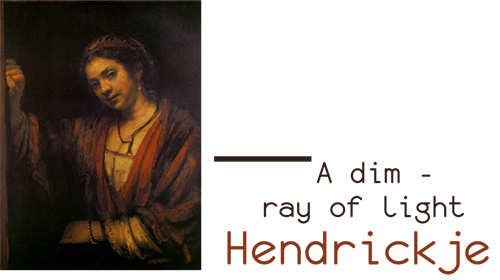
A Dim Ray of Light- Hendrickje
Hendrickje was a pleasant looking girl who belonged to Ransdorph, in Westphalia. She was almost half of Rembrandt’s age but was extremely attached to him. It did not matter to her whether Rembrandt could draw out a future for her or not. She was lost in love with the artist and had selflessly devoted herself to him. There was no uncertainty in the miserable scenes which were about to follow in Rembrandt’s life, and she could have easily escaped with another man who was young as well as rich. But maybe, for her, the most important wealth was Rembrandt. There were ample of reasons for her to leave him; of them, the most important one was, though she had almost taken the place of a wife in Rembrandt’s life, she very well knew that Rembrandt could legally never marry her. The reason behind this was Saskia’s will, according to which, Rembrandt had to pay 20,375 florins to Louis Crayers, the guardian of Titus before getting married to anybody. But for Hendrickje, the world was glowing until Rembrandt was beside her.
Though Rembrandt had all the support which Hendrickje and his son Titus could offer; he was over as an artist for the people of his town. Ultimately, after 1649 he inched closer to bankruptcy. The first evidence for the same was, when he ceased to pay the instalments and the interest which was due for his house. The second indication came with Rembrandt selling the precious pearl necklace (which appears in so many of his pictures) between the years 1650 and 1652 to Phillips Koninck, his ex-student.
The people who piled on outside Rembrandt’s house to learn his art were considering others instead of him as he was no more ready to follow the on-going trend.
It was obvious that Rembrandt had no money left to lead a content life ahead and so he began taking debts. There were numerous people from whom he borrowed money and promised to pay back. But unfortunately, destiny never returned him the wealth which he once possessed and all the debts remained ‘debts’ only. It seemed as if Rembrandt’s life was nearing its end and he was cursed with a bad fate.
When people looked at Rembrandt it seemed no hope was left for the painter; but he could still see a ray of hope which he believed would shine one day. Though people no longer coveted him to paint them, his friends still had a mania to be etched and painted by him. Unfortunately, bad luck had hit Rembrandt in such a terrible way that neither earnings nor loans could help him rise once again.
Meanwhile, Hendrickje gave birth to Rembrandt’s child, in 1652, but sadly, the child did not survive for long. Soon in 1654, Hendrickje was blessed with another daughter whom they named Cornelia. Though without money, still the family was filled with contentment with the entry of a new born adorable child.

Fading Away…
Rembrandt was formally declared bankrupt in the year 1656. An inventory was made “of paintings, furniture and domestic utensils connected with the failure of Rembrandt Van Rijn, formerly living in the Breestraat near the lock of St. Anthony.” Everything which Rembrandt possessed was out for sale in an auction, including the house in which he had spent eighteen years of his life. It was an auction not of his property, but of his feelings, his memories and his emotions.
Everything was nearing its end but it could not lessen the love which Rembrandt, Titus and Hendrickje had for each other. Though Rembrandt never married Hendrickje, she was still very much a mother to Titus and a wife to him. The family seemed united, however tough the times were. The unity among them portrays in Titus’ will which says that all the wealth which he possessed in his trust will be left for Hendrickje and Cornelia and shall also be used for Cornelia’s marriage.
After bankruptcy, Rembrandt moved to ‘The Crown Imperial Inn’, a commodious house which once had been the municipal orphanage and was now the customary place for holding auctions. On 25th December, the sale of Rembrandt’s property began in this very house where he was lodging. Soon, his house was sold to someone named Lieven Simonsz for 11,218 florins,
followed by all his arts and paintings, for a ridiculous sum of just 5000 florins. What a moment of sorrow it might have been for Rembrandt to sell everything that he had collected all his life and painted with such dedication.
But it is pleasant to find that during all this mess, Rembrandt’s friends stood by him and helped him get some commissions. Along with friends and family, Hendrickje too always stood beside him. On 15th December, 1660 Hendrickje made a final effort to restore the happiness which had faded away altogether. She partnered up with Titus into a legal association for the purpose of dealing in pictures and engravings. Both of them contributed to the fund with the amount of money that they were left with and decided to share half of the stock. As Hendrickje had no knowledge regarding business and Titus was still not mature, Rembrandt was the only one who could assist them in the venture. Finally, it was decided that as Rembrandt was assisting in furthering the interests of the firm, he should be provided board, lodging and certain allowances. Though this judicial arrangement was made for the sake of Rembrandt by his family, his creditors did not appreciate the new association; they were fierce in their protests.
Finally, Rembrandt once again settled down in Rozengratch which was a house opposite to a pleasure garden called Doolhof. In 1661, an old friend Van De Capelle, a painter and a dyer, once again came to Rembrandt’s rescue and offered him a commission to paint ‘The Syndics of The Drapers Gill’. But unfortunately, Rembrandt could not escape the demise which was set for him by his destiny. The trouble which he faced now was of weak eyesight due to which he could no more etch and paint the way he used to before. During these years of his life he repeatedly suffered one stroke after another. On 7th August, 1661, his only companion Hendrickje all of a sudden fell so seriously ill that she decided to make her will the same day. The will stated that all the property would go to Cornelia and in case of her death, Titus would inherit the same. Rembrandt could enjoy the income as long as he lived. Though after this day she is supposed to have recovered for a short while, the angel of death took her away very soon in the year 1663.

Last Days
After Hendrickje’s death, the ray of hope almost vanished from Rembrandt’s life. The last pupil who came to him during this period was Aert de Gelder. Maybe he might have helped him smile in the worst times of his life for a moment but nothing seemed to help the ‘poor broken old man’. By this time people hardly could hear of the painter or see him; it seemed as if he was lost somewhere in the midst of loneliness.
Along with loss of sight, his health also began to deteriorate.
The only thing which may have made him happy during this period was the wedding of Titus with his cousin Magdalena on 28th February, 1668. But unfortunate as he was during those days, Rembrandt was struck by the death of his son Titus on 4th September, 1668.
The long downward struggling journey of the greatest painter ever- Rembrandt Van Rijn finally came to an end and he was buried in the grave at the foot of a staircase of a church at the cost of thirteen florins, never to come back. “Tuesday, 8th October,1669, Rembrandt Van Rijn, painter, on the Rozengracht, opposite the Doolhof. Leaves two children.” Death is a part of nature and someday it has to come to one and all, but people who survive in this world even after they die are called great; one of them was Rembrandt Van Rijn, the greatest painter who was ever born.
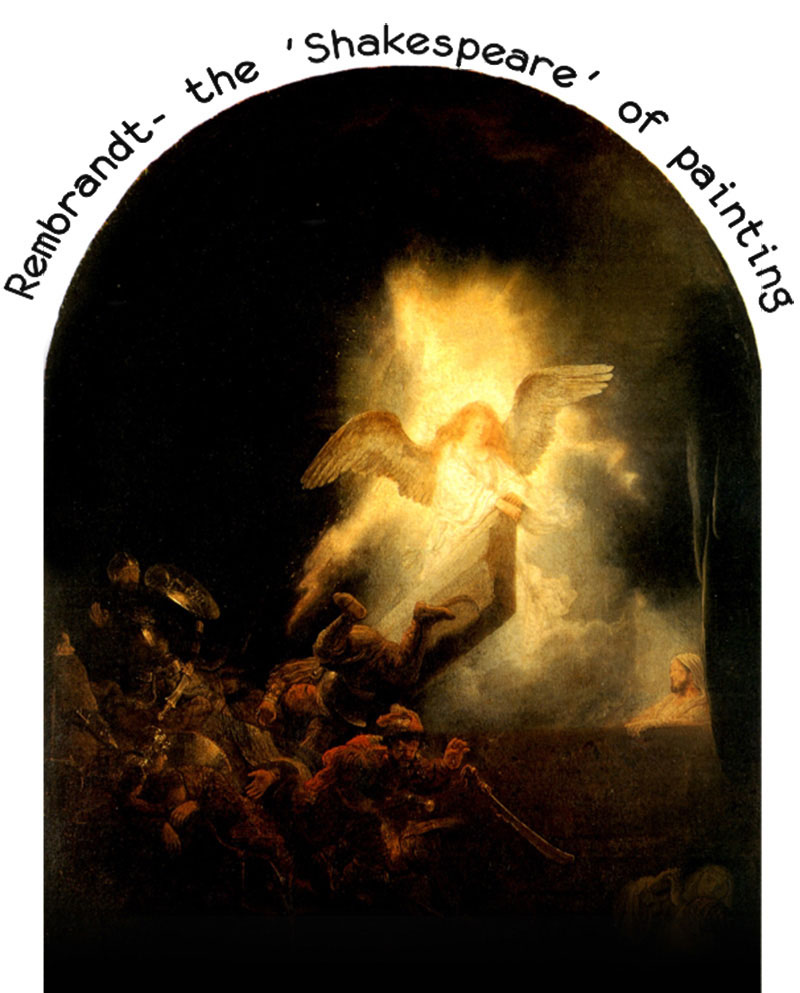
Rembrandt- The ‘Shakespeare’ of Painting
“Rembrandt is so deeply mysterious that he says things for which there are no words in any language. Rembrandt is truly called a magician…that’s not an easy calling.” Indeed, magic is the apt word to describe Rembrandt’s paintings. It is astounding to see how everything that Rembrandt ever painted still looks so real. “Like Shakespeare, he seems to have been able to get into the skin of all types of men, and to know how they would behave in any given situation.” He observed the world more vividly and intensely than any other painter.
The most prominent characteristic of his work was the use of ‘chiaroscuro’. No painter has ever equalled Rembrandt’s ‘chiaroscuro’ effects or his ‘bold impasto’ (the thick application of a pigment to a canvas in painting). He could unveil the hidden mysteries behind every face; he could express every tear and every smile through his paintings. He possessed the art to unveil the love, agony, avarice and malice behind every mysterious eye.
Perhaps, no artist ever painted so many self-portraits. There are numerous artists who have painted others but Rembrandt was the first one to hold the mirror to himself. His paintings are a mirror to his emotions, ideas and life. His portraits unlock his mysterious unspoken words even today.
The late nineteenth century critic Emile Michel says, “Rembrandt, in effect, belongs to the race of artists who cannot have descendants, the race of Michelangelo, the race of Shakespeare, of Beethoven; like these Prometheuses of art he wanted to ravish the celestial life, to put the vibrations of life into still form, to express in the visible, that which by its very nature is non-material and indefinable.”
Although the sun sets daily, it still sends down powerful and splendid rays every time it rises, same is the effect of Rembrandt. Though his eyes are closed today, we can still see what they once saw in this mysterious world.
“Though I have long been gone from this life,
I have left a little light in some selective people’s eyes.
They aren’t the ones on earth that are readily recognized.
So, take a closer look and you might be surprised.
Don’t be so quick to dismiss or criticize.
I am Rembrandt and I live on in the hearts and minds
Of those who are forgotten and left behind.”
Next Biography





